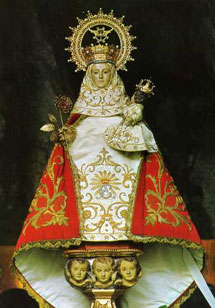marian anniversaries september
La Santina, Covadonga, Asturias, Spain
 High in the mountains of northern Spain, the cave of Covadonga was probably already a shrine to the Virgin in 718, when Don Pelayo's small Christian
brigade hid there from a much larger Arab army, living on honey in the rocks. As Alkamán's forces approached, Pelayo and his men sent up a continual prayer to the Virgin for help.
A wind arose and sent the missiles directed toward the cave back to their source in a thick volley. As the Moors retreated in disarray, Pelayo advanced. Alkamán died along with
most of his forces, the rest of which fled to the valley, where they were buried by an avalanche. This early Spanish victory, considered the beginning of the
Reconquest, made
remote Covadonga one of the best known and loved Marian shrines in Spain. It has a spring credited with special powers:
High in the mountains of northern Spain, the cave of Covadonga was probably already a shrine to the Virgin in 718, when Don Pelayo's small Christian
brigade hid there from a much larger Arab army, living on honey in the rocks. As Alkamán's forces approached, Pelayo and his men sent up a continual prayer to the Virgin for help.
A wind arose and sent the missiles directed toward the cave back to their source in a thick volley. As the Moors retreated in disarray, Pelayo advanced. Alkamán died along with
most of his forces, the rest of which fled to the valley, where they were buried by an avalanche. This early Spanish victory, considered the beginning of the
Reconquest, made
remote Covadonga one of the best known and loved Marian shrines in Spain. It has a spring credited with special powers:
|
The Virgin of Covadonga |
The statue was crowned on the Virgin's feast day, September 8, 1918. Since 1957 a plastic statue has been used for pilgrimages from Covadonga to the rest of Asturias. (Photo from www.el-caminoreal.com.)